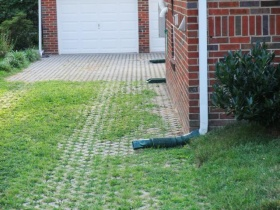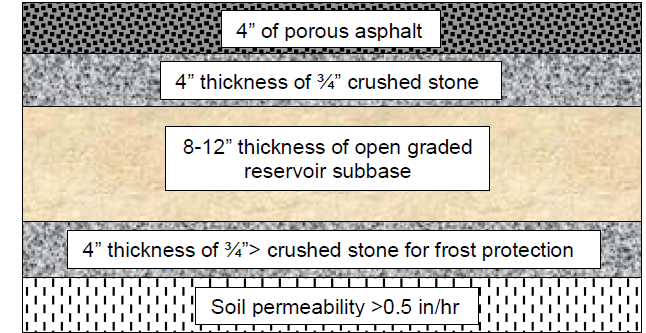Impervious surfaces are hard surfaces, such as sidewalks, roads, parking lots, and rooftops, which do not allow water to seep into the ground. Rainwater falls onto these surfaces and picks up various pollutants such as oils, grease, nitrogen, fertilizers, pesticides, and pet and wildlife waste. During storms, accumulated pollutants are quickly washed off these surfaces and transported to local streams, lakes, rivers, or estuaries. This water is referred to as “stormwater runoff.”
As areas become more densely developed, a larger percentage of land is covered by impervious surfaces, thereby increasing the volume of water and pollutant load to local waterbodies. In addition to the pollutant load, imperviousness affects the stability of streams (widening of stream banks and/or downcutting of stream bed), stream temperature, and biodiversity. In a review of published literature, the Center for Watershed Protection found that stream degradation occurs at a relatively low level of imperviousness, approximately 10%.
Why reduce impervious surfaces?
It has been repeatedly shown through scientific studies that pollutant loads are directly related to the amount of impervious surface in a watershed. If impervious surfaces are reduced, the volume of water and pollutant load transported to local waterbodies is also reduced.

How can I reduce impervious surfaces on my property?
There are a couple options, it will depend on what the impervious area is used for. For a sidewalk that doesn’t get heavy traffic, the impervious material could be removed and the area could be vegetated. For a driveway, you could replace traditional asphalt and concrete surfaces with permeable asphalt or concrete or permeable pavers.
What is permeable pavement and what are the benefits?
There are two basic design variations: porous pavement and permeable pavers. Porous pavement consists of either permeable asphalt or permeable concrete with an underlying stone reservoir. Porous pavement looks similar to conventional pavement, except that it is formulated to leave void spaces for infiltration. Permeable pavers include reinforced turf, interlocking concrete modules, and brick pavers. Permeable pavers are also designed so that rainfall infiltrates through the surface and into the soil below.
Infiltration of rainwater through permeable pavement decreases polluted stormwater, recharges groundwater, and filters out pollutants as water moves through the underlying soils.

What does the installation of porous asphalt require?
Because runoff infiltrates through the pavement into underlying soil, porous asphalt systems require installation of a gravel base course that acts as storage. Figure 1 shows a typical porous asphalt cross-section. The three main design components are: surface, storage, and outflow. For porous asphalt, the surface is the permeable asphalt. The storage component includes a choker course of smaller aggregate to separate the storage bed from the surface course and coarse aggregate laid beneath the choker course.
The filter course is a gravel bed made out of clean washed aggregate and acts as a filter for rainwater. The reservoir course consists of thicker stones and functions as water detention. The bottom of the reservoir course should ideally be flat, but if that is not possible, it should not slope more than 5 percent. Additionally, the reservoir must be located:
- At least 3 feet above the seasonal-high groundwater table
- 25 feet down gradient from structures and septic systems
- At least 100 feet away from drinking water wells
If you are interested in installing porous asphalt, refer to your state’s stormwater management design manual for sizing and design criteria. In New York, please refer to the current version NYS Stormwater Management Design Manual.
How do I maintain my permeable pavement?
The ability to perform regular maintenance is important to the long term success of your permeable pavement.
Proper maintenance is also dependent on what kind of porous pavers you use. If you choose to use a paver that includes grass turf, it may require normal turf maintenance such as mowing, seeding, and watering. Concrete grid pavers and plastic modular bricks require less maintenance than porous asphalt and concrete as they clog less easily. Areas with frequent vehicular traffic will also clog more easily, due to soil compaction. Permeable pavement should be maintained as follows:
- Ensure that paving area is clean of debris every month
- Ensure that paving area dewaters every month after storms that are greater than .5 inches of rain
- Ensure that area is clean of sediment to avoid clogging.
- Mow upland and adjacent areas, and seed bare areas as needed. Avoid getting fertilizers, pesticides, and chemicals on concrete products.
- Inspect surface for deterioration every year